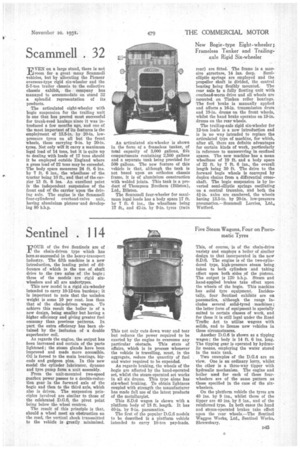Sentinel . 114
Page 33

If you've noticed an error in this article please click here to report it so we can fix it.
FOUR of the five Sentinels are of the chain-driven type which has been so successful in the heavy-transport industry. The fifth machine is a new introduction, the leading point of difference of which is the use of shaft drive to the two axles of the bogie ; three of the models are rigid sixwheelers and all are naclertYPes
This new model is a rigid six-wheeler intended to carry 10-12-ton burdens; it is important to note that the unladen weight is some 10 per cent less than that of the chain-driven wagon. To achieve this result the boiler is of a new design, being smaller but having a higher efficiency and giving greater fuel economy than previous patterns. In part the extra efficiency has been obtained by the inclusion of a doable superheater coil.
As regards the engine, the output has been increased and certain of the parts lightened; the steam glands have been improved and made more accessible. Oil is forced to the main bearings, bigends and gudgeon pins. In this new model the cylinder lubricator, dynamo and tyre pump form a unit assembly.
From the unit-mounted two-speed gearbox power _passes to a double-reduction gear in the forward axle of the bogie and then to the third axle, which also is driven. The suspension principles involved are similar to those of the celebrated D.G.6, the pivot point being below the wheel centres.
The result of this principle is that, should a wheel meet an obstruction on the road, the vertical shock transmitted to the vehicle is greatly minimized. This not only cuts down wear and tear but reduces the power required to be exerted by the engine to overcome any particular obstacle. This state of affairs, which is in process whenever the vehicle is travelling, must, in the aggregate, reduce the quantity of fuel and water required to be expended.
As regards braking, the wheels of the bogie are affected by the band-operated set, whilst the steam-operated set works in all six drums. This type alone has six-wheel braking. To obtain lightness coupled with strength the manufacturer has made full use of the latest products of the metallurgist.
This S.D.6 wagon is shown with a platform body of 18 ft. length. It has 40-in. by 9-in. pneumatics.
The first of the popular D.G.8 models to be described is a platform vehicle intended to carry 10-ton pay-loads. This, of course, is of the chain-drive variety and employs a boiler of similar design to that incorporated in the new S.D.6. The engine is of the two-cylindered type, high-pressure steam being. taken to both cylinders and taking effect upon both sides of the pistons. The output is 120 b.h.p. Steam and band-applied brakes take effect upon the wheels of. the bogie. This machine has solid tyre equipment. Incidentally, four Sentinel exhibits are on pneumatics, although the range includes several solid-tyred machines ; the latter form of equipment is specially suited to certain classes of work, and for these it is still legal under the Road Traffic Act to utilize wagons with solids, and to license new vehicles in these circumstances.
Another D.0.8 is shown as a tipping wagon-; the body is 14 ft. 6 ins. long. The tipping gear is operated by hydraulic means, employing the water stored in the main tank.
Two examples of the D.G.4 are on view. One is an ordinary lorry, whilst the other is a three-way tipper with hydraulic mechanism. The engine and boiler used for each of these fourwheelers are of the same pattern as those specified in the case of the sixwheelers.
On the piatferm vehicle the tyres are 40 ins. by 9 ins., whilst those of the tipper are 40 ins. by 8 ins., and of the reinforced type. In both cases the hand and steam-operated brakes take effect upon the rear wheels.—The Sentinel Waggon Works, Ltd., Sentinel Works. Shrewsbury,
















































































































































